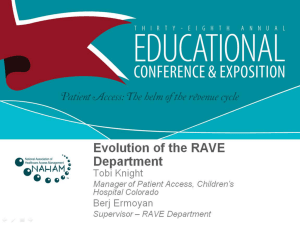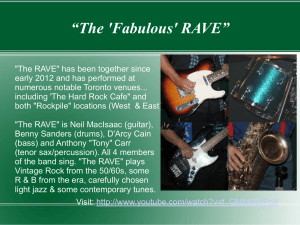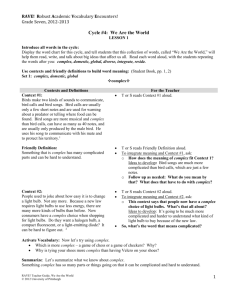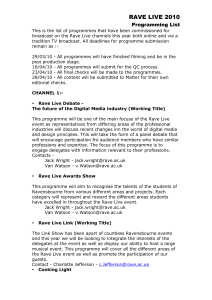Subculture Literature Research Paper
advertisement
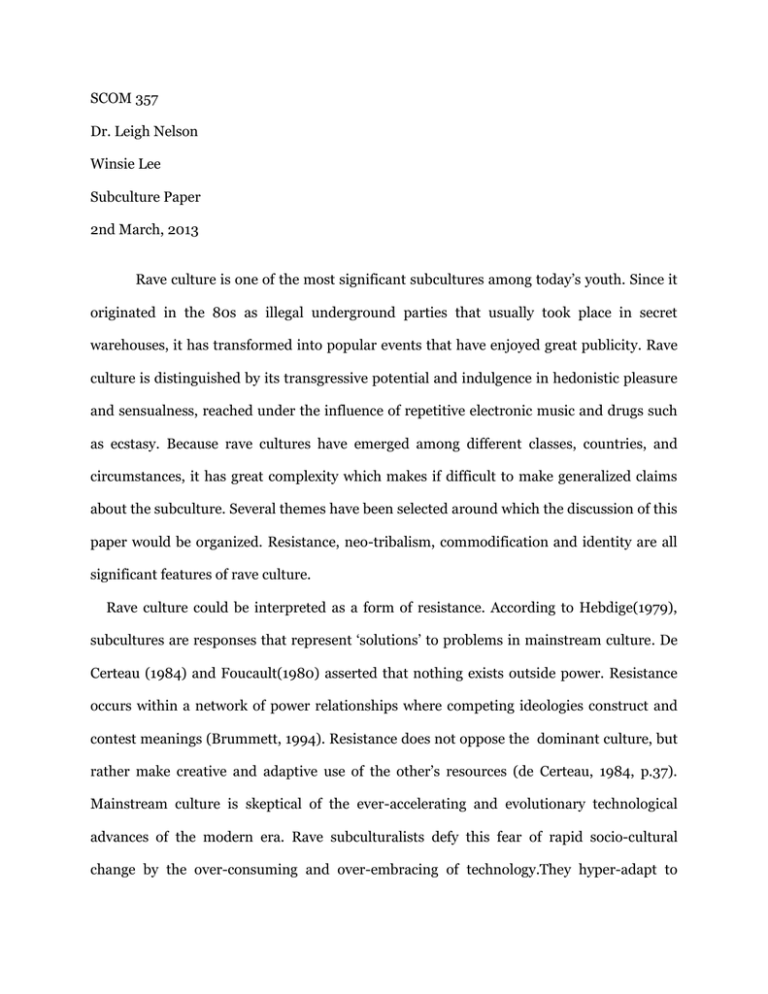
SCOM 357 Dr. Leigh Nelson Winsie Lee Subculture Paper 2nd March, 2013 Rave culture is one of the most significant subcultures among today’s youth. Since it originated in the 80s as illegal underground parties that usually took place in secret warehouses, it has transformed into popular events that have enjoyed great publicity. Rave culture is distinguished by its transgressive potential and indulgence in hedonistic pleasure and sensualness, reached under the influence of repetitive electronic music and drugs such as ecstasy. Because rave cultures have emerged among different classes, countries, and circumstances, it has great complexity which makes if difficult to make generalized claims about the subculture. Several themes have been selected around which the discussion of this paper would be organized. Resistance, neo-tribalism, commodification and identity are all significant features of rave culture. Rave culture could be interpreted as a form of resistance. According to Hebdige(1979), subcultures are responses that represent ‘solutions’ to problems in mainstream culture. De Certeau (1984) and Foucault(1980) asserted that nothing exists outside power. Resistance occurs within a network of power relationships where competing ideologies construct and contest meanings (Brummett, 1994). Resistance does not oppose the dominant culture, but rather make creative and adaptive use of the other’s resources (de Certeau, 1984, p.37). Mainstream culture is skeptical of the ever-accelerating and evolutionary technological advances of the modern era. Rave subculturalists defy this fear of rapid socio-cultural change by the over-consuming and over-embracing of technology.They hyper-adapt to digital society by integrating ‘high tech’ into leisure consumption to a great extent (Wilson, 2002).Unlike spectacular subcultures such as punks and skinheads who openly display anger and discontent, rave subculturalists’ resistance take on more subtle forms. They do not quite display resistance deliberately but rather give resistive meaning to their activities (Wilson, 2002). Rave subculturalists also resist mainstream culture’s hypocritical ‘critique of drugs but reverence of alcohol’. Other had suggested that the respectful nature of rave partying is a strategically symbolic reaction to the mainstream gendered and racially segregated nightclub/bar culture. Ravers interpreted this subtle resistance as a form of ‘tactical’ resistance(Wilson, 2002). Overall, rave subculturalists use ‘purposeful-tactital’ and ‘adpative-reactive’ forms of resistance. Rave culture does not quite oppose hegemonic culture from the outside but rather competes alongside it. Rave culture could be interpreted as a form of ‘neo-tribe’, an unstable transitory group that provides temporary escape from mundane everyday life (Goulding, Shankar,& Elliott, 2002). Neo-tribes are multiple and rarely dominate individual’s lives. A neo-tribe does not exclude members of other tribes or communities, but rather stresses the fluidity between different identities (Bennett, 1999). Because of this, neo-tribes emerge and disappear as members come and go (Muniz & O’Guinn, 2001; Muniz & Schau, 2005). There are five key elements of neo-tribalism ritual that enhance our understanding of rave culture: mythology, formulism, sacredness, communitas, and transformation. Mythology is a story of origin that sets the scene for subsequent expectations and experiences. Clubbing has a mythical foundation which came from the formative years of rave during which secrecy was imperative and communication was restrictive. Stories of origin survive into the present and are remembered personally or through narrative and music. There is also a nostalgia for the original scene, which was characterized by an underground hype. Myths provide a sense of history and help to sustain the neo-tribe’s continuity (Goulding, Shankar, 2011). The second key element of neo-tribalism ritual is formulism. It involves initiation, which leads to a process of conversion and commitment (Belk et al., 1989). ‘This requires leaving the ‘everyday’ behind for a period of physical and psychological re-adjustment, congregation and transformation.’ (Goulding, Shankar, 2011) A lot of excitement, anticipation, careful planning and preparation go into the initiation process. One rave subculturalist recalled her ritual of moving from being outside the group to becoming a fully member of the neo-tribe (Maffesoli, 1996). She started out as an ‘e’ virgin. A member gave her a tab and they waited for it to take effect. The fellow member’s company is required to make sure the new member can handle the drug. A lot of preparation and careful planning go into the big event. The new member usually plans the big night two weeks in advance. She had known about the venue, got the tickets and booked the bus, and prepared a couple hours immediately prior to the event. Eventually she took the pill, warmed up with the DJ, and danced for 3-4 hours, fully immersed in her transformative experience. Members of the rave culture, contrary to popular perception, have a code of etiquette and normative behavior to follow. They are expected to take ‘e’ so that they have the energy and state of mind to dance to repetitive music for a long period of time. They are not supposed to take alcohol because it is associated with aggression. Members of rave culture follow the procedures for psychological readjustment and participation and are socialized into the scene directly through the music played, the nature of dance, social interaction, and mental states (Goulding, Shankar, 2011) . Sacredness is the third element of neo-tribalism ritual. Rave culture includes common expressions of religious nature, such as ‘God is a DJ’, ‘Worship the weekend, ‘The Second Coming’ and ‘the Clubbers’ Bible’ Venues also have religious names, such as popular clubs ‘The Ministry of Sound’, ‘The Mission’, ‘The Sanctuary’, and even ‘The Church’. Rave culture emphasizes on ‘the sacralisation of time or ‘living for the weekend’ – a sense of separation and clear distinction between the working week and the clubbing weekend that offers a sense of release and an alternative way of being’ (Goulding et al., 2002). ‘Week time’ is the normal week occupied with work and general worries, while the weekend is devoted to becoming a different person in an alternate state of being. In this sense, the profane refers to ordinary everyday life, while the sacred is anything outside the ordinary (Belk et al., 1989). DJs are the shamans or spiritual leaders of rave culture. They play music with repetitive beats to create a trance state and awaken the crowd and heal their anxieties (Goulding, Shankar, 2011). Transformation is another key element of neo-tribalism ritual. Within rave culture, transformations occur in the body through dress and the physical exhilaration from dancing and transformations occur in the mind through music and drugs (Goulding, Shankar, 2011). This often involves ‘changes in perception of the environment (social or natural) and of the self’ (Stanfield & Kleine, 1990), as well as changes in the meaning of objects, people or experiences. Transformation involves a rite of separation that enables the clubber to separate from one mode of being and become a different person for a temporary period of time (Van Gennep, 1960). This ‘high’ must eventually end as disengagement from the ecstatic state and reintegration back into normality occurs (Goulding, Shankar, 2011). Last but not least, communitas is another crucial element of neo-tribalism ritual. Clubbing, ever since its beginning, has evolved around the notion of spontaneous communitas (Goulding, Shankar, 2011). Belk et al. (1989, p. 7) defined communitas as ‘a social antistructure that frees participants from their normal social roles and status and instead engages them in a transcending camaraderie of status of equality’. Most participants in the rave culture feel a sense of togetherness and equality. As they shed the constraints of everyday life in a levelling process, they recreate a society in which they worship shared objects and share experiences (Etzioni, 2000). This neo-tribal experience may lead to a rejection of individualism that is driven by a collective unconsciousness. In this communitas that temporarily deconstructs the social structure and reverses ordinary behavior, the identities of members may be expected to transcend individuality (Maffesoli, 1996). Because of the possibilities for multiple play, neo-tribes have a market orientation that set them on new paths for entrepreneurial ventures (Cova, Kozinets, & Shankar, 2007). Rave culture had originated as a communitas in which members share experiences, certain norms and values and connect with each other through ritualistic practices, and was gradually transformed into a commodity spectacle. Throughout the 1990s, ravers were relocated into clubs and discos, spaces meant for traditional spectacles. Music promoters began to sponsor spectacular outdoor raves with powerful sound systems, laser-light shows, and mass market DJs. Local radio stations made a lot of effort in advertising and ‘super’ raves drew huge crowds for $30-$60 a ticket. The music and record industry had especially derived much of its profits from the growing celebrity of the DJ. Popular, trade, and industry magazines promoted DJs as pop idols and caused great hype. They are interviewed in the media and the right lineup of DJs at an event always guarantees great success in music and event ticket sales. Commodification of the DJ and his/her music has been extended to his/her lifestyle as well. DJ trading cards, biographies, and bags can be seen in record stores, bookstores, and shopping mall boutiques offer DJ bags (Ott, Herman, 2003). The commodification of rave culture is linked to the identities of its constituents. Rave is an experience that offers its adherents an alternative way of being and allow them to construct and the manage the self (Goulding et al., 2002). People actively construct who they are, or want to be, from the symbolic resources that are available to them (Firat, Dholakia, & Venkatesh, 1995), ‘making a statement’ about themselves. In a postmodern consumer culture, identity is becoming more associated with active consumption of images and styles (Kellner, 1995; van Poecke, 1996) Fragmentation, a central theme of the postmodern approach to consumption, is the idea that markets have fragmented into smaller and smaller sectors, leading to an abundance of products to serve the rising number of sectors, which lead to the fragmentation and excess of the media (Firat & Venkatesh, 1995). As traditional instituitons(the church, marriage, family and workplace) that provided the formal basis of identity disintegrate, the self becomes more fragmented as consumption has become a major means of constructing and expressing identity. The changes in technology and media are accompanied by a greater emphasis on style, packaging, the aesthetic form and the ‘look (Goulding et al., 2002).’ Rave subculturalists project a particular image that is judged on the basis of such symbols as clothes, knowledge of the right kind of music, and the general ‘look’ to gain access and acceptance in the dance club. Shields (1992) had proposed that consumption spaces are social spaces, where the individual’s status is determined in the group’s favor. Members’ selfhood is recognized and confirmed in the subculture’s general environment (Goulding et al., 2002). Thompson and Haytko (1997, p26) had argued that fashion can be used to make one stand out with uniqueness or forge a sense of affiliation as well as a sense of belonging. The identities of rave subculturalists arc characterized by an alternating balance between individuality and collectivity. The neo-tribal communitas aspect of rave culture may cause rejection or transcendence of individualism to be fully immersed in the collective conscience. While subculturalist utilize various symbolic resources to construct and express their identities, they may also be subject to the judgment of their group. Fragmentation may suggest however that there would be a greater variety of sources to choose from which may contribute to more individual free choice. Rave culture, one of the most significant youth subcultures today, could be interpreted as form of resistance that, contrary to preconceived notions about resistance, is a subtle form that competes with the hegemonic culture. It could also be interpreted as neotribe, a fluid transitory group with five major ritualistic elements. It has also become a commodification spectacle and entrepreneurial venue. Finally, identities of the members of the rave culture are closely tied to a consumer market, and they often have to balance between individuality and collectivity. References: Belk, R., Wallendorf, M., & Sherry, J. (1989) The sacred and the profane in consumer behavior: Theodicy on the odyssey, Journal of Consumer Research, 16, 1–37 Bennett, A. (1999). Subcultures or Neotribes: Rethinking the relationship between youth, style and musical tastes, Sociology, 33, 599–614. Brummett, B (1994) Rhetoric in popular culture, New York. St Martin’s Press Cova, B., Kozinets, R., & Shankar, A. (2007) Consumer tribes. London: Elsevier. de Certeau, M (1984) The practice of everyday life. Berkeley CA University of California Press Etzioni, A. (2000) Toward a theory of public ritual. Sociological Theory, 18(1), 45–59. Firat, A., & Venkatesh, A (1995) Liberatory postmodernism and the re-enchantment of consumption, Journal of Consumer Research, 22(3), 239-267 Firat, A., Dholakia, N., & Venkatesh, A(1995) Marketing in a postmodern world, European Journal of Marketing, 29, 40-56 Foucault, M (1980). Power/knowledge: Selected interviews and other writings 1972-1977, (C. Gordon, L. Marshall, J. Mepham & K. Soper, Trans). New York: Pantheon Books Goulding, C., Shankar, A., & Elliott, R. (2002) Working weeks, club weekends: Identity fragmentation and the emergence of new communities, Consumption, Markets and Culture, 5(4), 261–284. Goulding, C., Shankar, A (2011) Club culture, neo-tribalism and ritualised behavior, Annals of Tourism Research, 38(4), 1435-1453 Hebdige, D (1979) Subculture:The Meaning Of Style. London: Methuen Kellner, D (1995) Media Culture. Cultural studies, identity and politics between the modern and postmodern. New York: Routledge Maffesoli, M. (1996) The time of the tribes: The decline of individualism in mass society. London: Sage. Muniz, A., & O’Guinn, T. (2001) Brand communities, Journal of Consumer Research, 27, 412–432. Muniz, A., & Schau, H. (2005) Religiosity in the abandoned apple newton brand community, Journal of Consumer Research, 31, 737–747 Ott, B.L., Herman, B.D (2003) Mixed Messages: Resistance and Reappropriation in Rave Culture, Western Journal of Communication, 67(3), 249-270 Shields, R. (1992) Spaces for the subject of consumption, In: R. Shields (Ed.). Lifestyle Shopping: The Subject of Consumption, Routledge, London Stanfield, M., & Kleine, R. (1990) Ritual, ritualized behavior, and habit: Refinements and extensions of the consumption ritual construct, Advances in Consumer Research, 17, 31–38. Thompson, C.J & Haytko, D.L(1997) Consumers’ uses of fashion discourses and the appropriation of countervailing cultural meanings, Journal of Consumer Research, 24(1), 15-42 Van Gennep, A. (1960) The rites of passage. Chicago, IL: University of Chicago Press. van Poecke, L (1996) Media culture and identity formation in the light of postmodern invisible socialization: From modernity to postmodernity, Communications, 21, 183-198 Wilson (2002) The Canadian rave scene and five theses on youth resistance, Canadian Journal of Sociology, 27(3), 373-408


